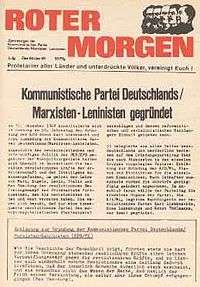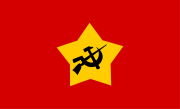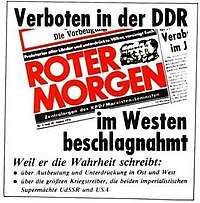Communist Party of Germany/Marxists–Leninists
The Communist Party of Germany/Marxist–Leninist (German: Kommunistische Partei Deutschlands/Marxisten-Leninisten, KPD/ML), established on December 31, 1968, was an anti-revisionist pro-China party in West Germany that was later supportive of communist leader of Albania Enver Hoxha after the Sino-Albanian Split. The KPD/ML was formed by former Communist Party of Germany (KPD) official Ernst Aust, who subsequently became the party's chairman, on New Year's Eve 1968 as a split from the KPD. Its periodical was Roter Morgen.

Communist Party of Germany/Marxists–Leninists | |
|---|---|
 | |
| President | Ernst Aust |
| Founded | December 31, 1968 |
| Dissolved | 1986 |
| Ideology | Communism Marxism–Leninism Maoism (until 1979) Anti-revisionism |
| Political position | Far-left |
| International affiliation | pro-Albanian[1] |
| |
Aust was received by Albanian leader Enver Hoxha in a private audience in 1974, while, on June 1, 1975, Yao Wenyuan, a member of the central committee of the Communist Party of China received the KPD/ML chairman.
The KPD/ML had its final break with Maoism in 1977. In 1978, with the adoption of a new programme adopted at the party's fourth congress, the KPD/ML disassociated itself from the Three Worlds Theory of the Communist Party of China. Relations between the KPD/ML and the Party of Labour of Albania had significantly cooled by 1984.
In 1986, the KPD/ML merged with the International Marxist Group (GIM) to form the Unified Socialist Party (VSP).
A handful of members opposed to the VSP split off and formed many parties in the tradition of Aust's KPD/ML after 1986, the most prominent being the Communist International (Stalinists-Hoxhaists), Arbeit Zukunft and the Communist Party of Germany (Roter Morgen). These groups maintain or maintained a strong anti-revisionist ideology.
GDR Section
At the end of 1975 and beginning of 1976, the foundation by the KPD/ML of its own section in the GDR was made public. The corresponding declaration was published in Roter Morgen on February 7, 1976.[2]
While the KPD/ML had already been formed in 1968 in the FRG, the nucleus of the GDR Section emerged within the GDR itself.
In the beginning of the 1970s, some students in the eleventh and twelfth grades at an Extended Secondary School (Erweiterte Oberschule; EOS) in Berlin got together to study the texts of the classical authors of Marxism–Leninism independently of the official version propagated by the Socialist Unity Party. They were not the only ones in the GDR doing this at that period.
Other interested people among their friends and families joined them, so that, in the course of time, a little circle of employees (in the education and technical fields) and students (of medicine, language and literature) was formed. In reading the basic texts of Marxist–Leninist social theory they came more and more to the conclusion that a deep gap existed between theory and practice in "actually existing socialism".

In Magdeburg, during 1969-70, pupils, students and apprentices got together to form the Progressive Youth (Progressive Jugend), inspired - among other things - by the Black Panthers. Besides the classical authors of Marxism–Leninism, various forbidden texts (of Mao, Stalin, the Black Panthers, etc.) were read and discussed by this youth group, whose activities were GDR-wide and which was composed of around 100 young people.
After the Progressive Youth had been disintegrated and destroyed, in 1976 the "hard core" of the Progressive Youth formed a KPD/ML cell.
In Rostock, too, an autonomous circle of students was formed with a similar political orientation. Being interested in further ideological inspiration, many of these groups and circles - by themselves - got in touch with various left organizations in West Berlin and with the Albanian embassy in East Berlin.
Besides the young people, who were the majority within the GDR Section, some older, battle-hardened comrades joined the Section. For instance, Heinz Reiche, who had spent 11 years in Nazi prisons and concentration camps, took part in activities in Weisswasser (a township south of Cottbus). Reiche had already come into conflict with the SED in the 1950s.
During the following years, the KPD/ML was successful in gaining supporters and organizing them into party cells in the GDR. These cells were inspired by the cell system of the illegal KPD during the Nazi dictatorship.
Until 1980, according to information from Stasi files, almost a dozen such cells were formed. The total number of members or supporters of the KPD/ML in the GDR amounted to three dozen people. In addition, there were about 50 to 60 sympathizers who were in direct personal contact with the above-mentioned circle.
Notes
- Hobday, Charles (1986). Communist and Marxist Parties of the World. Harlow: Longman. p. 72. ISBN 0-582-90264-9.
- New Revelations about the Activities and Destruction of the GDR Section of the Communist Party of Germany/Marxist-Leninist (KPD/ML)
References
- Situation Report by the Working Group XXII of the Berlin BV (regional administration of the Stasi) on the Present State of Investigation of the GDR Section of the 'Communist Party of Germany', January 18, 1982